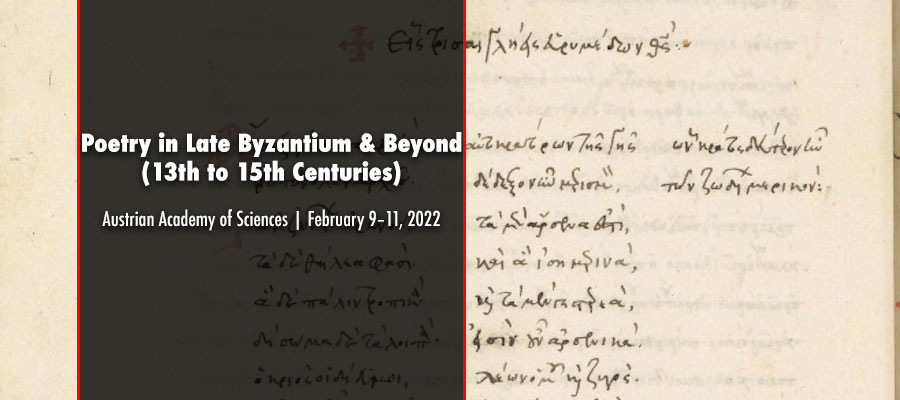Poetry in Late Byzantium and Beyond (13th to 15th Centuries), Austrian Academy of Sciences, February 9–11, 2022
The composition and consumption of poetry was fundamental for the cultural life of the Byzantines, from the beginning of the Empire until its end in the middle of the 15th century. In the schools, poetry was omnipresent both as an object of study (such as that of Homer, the tragedians, and Gregory of Nazianzus, as well as of more contemporary authors, e.g. Michael Psellos or Theodore Prodromos), and as a teaching method (didactic poems, metrical schede). Epigrams were omnipresent in Constantinople and elsewhere, inscribed on the surfaces of churches and towers, icons, and portable objects, as well as in many other places and settings. Members of the upper class regularly gathered in literary salons, the so-called theatra, where rhetorical texts were read in both prose and verse. Moreover, beyond its undoubted aesthetic value, the writing and patronage of poetry could have a significant impact on the social standing of authors and patrons alike. While these aspects have recently been studied for the poetry produced from late antiquity up to the twelfth century, the poetic production of the late Byzantine period (13th to 15th c.) has been largely neglected. This conference will, for the first time, shed light on the corpus of late Byzantine poetry in its entirety. We invite the submission of papers with a focus on metrical texts from the Byzantine world from the 13th to the 15th centuries. Topics that might be addressed include:
- An uncharted territory: Although recent years have seen the publication of new critical editions and case studies, a large part of the poetic output of late Byzantium is still very poorly known and understood. Apart from familiar figures such as Manuel Philes, Maximos Planudes or Theodore Metochites, who was writing the poetry of this period, and for whom? What kind of texts did they write? Which sociocultural contexts most stimulated the composition of poetry?
- Social practices and aesthetic choices: How do aesthetic choices (meter, language register, verse or prose, rhetorical guise, etc.) reflect the distinctive social contexts in which particular poems were written? Where was poetry produced, read or listened to, and otherwise employed and why? What were its true functions?
- Poetic traditions: Byzantine literature thrived on the interplay between the imitation of earlier authors (mimesis) and the search for original compositions within this framework. What role did this orientation play in a time when the very existence of the empire was threatened? Which texts and authors were regarded as models, and what innovations did their work inspire? On the other hand, how did Byzantine poetry survive (and prosper) after the fall of Constantinople?
- Byzantium and beyond: In recent years, scholarship has increasingly focused on the entanglements of the “Global Middle Ages”. Byzantine literature, however, has mostly been studied in isolation, even though Greek-speaking communities lived under various political regimes and in a variety of sociocultural and linguistic circumstances, especially in the 13th to the 15th centuries. How was Greek poetry influenced by these cultures, and what was its impact on their poetic production? And how was Byzantine poetry regarded by the non-Byzantine eye?
This, of course, is a provisional list of questions to which we are happy to add more suggestions. Moreover, we welcome papers on editorial projects of twelfth-century poems that are in progress.
Organizer: Dr. Krystina Kubina (Austrian Academy of Sciences)
This conference is organized within the framework of the project “Late Byzantine Poetry (from the Fourth Crusade until the End of the Empire” (T1045 – G25) funded by the Austrian Science Fund FWF.
